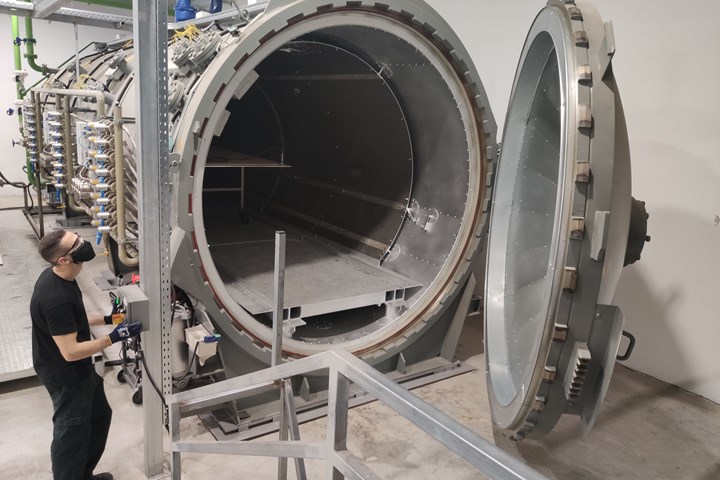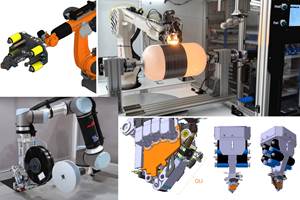Kanfit installs new autoclave, automated cutter to increase composite parts production capacity
Composite parts producer in Israel increases capabilities for composites, 3D printing and hybrid assemblies.

Kanfit Ltd. (Nof Hagalil, Israel) has installed a new 2.5-meter-diameter by 8.2-meter long autoclave from Scholz (Coesfeld, Germany), adding to its 2.1-meter-diameter by 5.5-meter-long autoclave from ASC Process Systems (Valencia, Calif., U.S.), which has served the company’s production needs since 2015. The new Scholz autoclave was purchased to increase Kanfit's in-autoclave production capacity as well as to manufacture larger parts. The new Scholz autoclave is 2.5 times larger in volume than its ASC autoclave, and allows the production of parts up to 8.2 meters long.
In addition, Kanfit added a Zünd (Altstätten, Switzerland) fabric cutting machine with conveyor table. The company's new cleanroom has doubled to 400 square meters and its prepreg storage freezers have twice the capacity of its previous plant in Migdal Ha'Emek.
Three new LASERGUIDE projections systems from Aligned Vision (Chelmsford, Mass., U.S.) were also added to the four already in place. A new fume hood from Pach Taas (Ashkelon, Israel) has also been added for mold preparation, as well as new laboratory equipment to increase Kanfit’s composite testing capabilities, including a 100-kilonewton universal testing machine from Shimadzu (Kyoto, Japan) and a thermal-mechanical analysis system for glass transition temperature and dynamic mechanical analysis (DMA) from TA Instruments (New Castle, Del., U.S.).
Kanfit Ltd.’s sister company, KANFIT3D, also recently increased its production capacity, installing an SLM M280 selective laser melting system for aluminum parts. KANFIT3D has begun additive manufacturing of 3D components for the aerospace industry.
“Both the autoclave and SLM machine were installed remotely,” notes Shachar Fine, Kanfit executive vice president of business development, marketing & sales. “As far as we are aware, this is the first time that remote installation has been performed for both of these systems. We are already manufacturing parts according to customer requirements.”
“Fortunately, during this difficult time, our production capabilities have not been disrupted,” says Fine, “and we continue to work at full capacity to provide our customers with the highest quality composite and metal parts for the aerospace industry. We are committed to get through these perverse times with minimal interruption and see a bright future once this challenge is passed.”
Remote installation
"The new autoclave arrived at our factory at the same time as the COVID-19 pandemic. We quickly understood that Scholz would not be able to send a technical team to Israel for installation as planned," explains Shachar Fine, EVP of Business Development, Sales & Marketing at Kanfit. "It was a difficult situation. We already had orders to fill, and any interruption in production would have been costly to Kanfit and to our customers. We are grateful to Scholz for going above and beyond in getting the new autoclave up and running in the same amount of time as if they would have physically been here on-site."
The autoclave was installed at Kanfit by its technical team according to Scholz specifications, remotely guided via cell phone video calls between the two companies. Marius Graeber, managing director of Scholz, notes that these are extremely complicated times, and that this situation has never been encountered before. “It was either wait until the COVID-19 crisis ended or take action—and I am happy to say we were up to the challenge,” he says.
Fine points out that the autoclave’s water treatment system was designed in-house, allowing for the cooling of all Kanfit's autoclave processes. The system is also supported by a cooling tower and heat exchanger with two water cycles.
The autoclave is currently undergoing qualification processes in-house in accordance with customer requirements. Kanfit has already produced aerospace components in the autoclave that are more than six meters in length.
Related Content
PEEK vs. PEKK vs. PAEK and continuous compression molding
Suppliers of thermoplastics and carbon fiber chime in regarding PEEK vs. PEKK, and now PAEK, as well as in-situ consolidation — the supply chain for thermoplastic tape composites continues to evolve.
Read MoreLarge-format 3D printing enables toolless, rapid production for AUVs
Dive Technologies started by 3D printing prototypes of its composite autonomous underwater vehicles, but AM became the solution for customizable, toolless production.
Read MoreThe next evolution in AFP
Automated fiber placement develops into more compact, flexible, modular and digitized systems with multi-material and process capabilities.
Read MoreA new era for ceramic matrix composites
CMC is expanding, with new fiber production in Europe, faster processes and higher temperature materials enabling applications for industry, hypersonics and New Space.
Read MoreRead Next
Plant tour: Daher Shap’in TechCenter and composites production plant, Saint-Aignan-de-Grandlieu, France
Co-located R&D and production advance OOA thermosets, thermoplastics, welding, recycling and digital technologies for faster processing and certification of lighter, more sustainable composites.
Read More“Structured air” TPS safeguards composite structures
Powered by an 85% air/15% pure polyimide aerogel, Blueshift’s novel material system protects structures during transient thermal events from -200°C to beyond 2400°C for rockets, battery boxes and more.
Read MoreAll-recycled, needle-punched nonwoven CFRP slashes carbon footprint of Formula 2 seat
Dallara and Tenowo collaborate to produce a race-ready Formula 2 seat using recycled carbon fiber, reducing CO2 emissions by 97.5% compared to virgin materials.
Read More
























